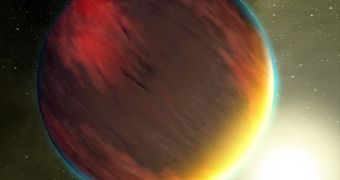A team of astronomers investigating extrasolar planets has recently determined one of the main reasons why these celestial bodies have radii that are a lot larger than they should be.
The fact that this class of exoplanets is “puffy” has been known for quite some time, but experts have until now been unable to determine precisely why that happened.
When calculating the radius of a planet, there is a large number of factors to be kept in mind, but none of them was sufficient to account for the inflation that hot Jupiter-class planets showed.
According to the newly-devised theory, it may be that the excess inflation develops in areas of the atmosphere that exhibit the largest amount of circulation. All the extra energy makes these regions swell up.
The research team behind the new work believes that the excess energy is then converted to heat, which in turn causes the atmosphere to expand altogether, Universe Today reports.
The source of this excess energy has also been a mystery until now, but experts at the University of Colorado in Boulder (UCB), led by scientist Rosalba Perna, say that the energy comes from ionized winds.
These air movements pass through intense magnetic fields, which are caused by the fact that hot Jupiter planets, as a rule, orbit their parent stars at very close distances.
In our own solar system, Jupiter has the strongest ionized wind the researchers determined. It is approximately 14 times more intense than Earth's.
This means that, while our planet's magnetosphere protects us at close range, Jupiter's protects the gas giant by extending up to 7 million kilometers above the surface of the planet.
When charge particles emanating from the Sun interact with this enormous magnetosphere, huge and bright auroras are produced, which look strikingly similar to those on Earth. Size is the only difference.
The UCB team demonstrated that ionized winds in the atmosphere interact with strong magnetic fields, producing drag that results in heat. Friction is therefore the explanation for why hot Jupiters are so inflated.
But not all are convinced about the new idea. A magnetic flux density of 10 Gauss is needed to back it up, but some studies have shown that exoplanets have less Gauss when they become tidally locked to their parent stars.
When two bodies become tidally locked, they always keep the same face oriented to each other. A good example is the system formed by Earth and the Moon.

 14 DAY TRIAL //
14 DAY TRIAL //